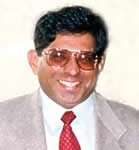|
 ven though the free market rules the business world, government policies and regulations on trade can shape the industry structure. Usually companies prefer more free trade and less government regulation. Companies like access to markets that provide higher revenues and higher profits, while governments like higher employment for its citizens. Sometimes these intentions can be contradictory.
ven though the free market rules the business world, government policies and regulations on trade can shape the industry structure. Usually companies prefer more free trade and less government regulation. Companies like access to markets that provide higher revenues and higher profits, while governments like higher employment for its citizens. Sometimes these intentions can be contradictory.
The electronic trade is vastly global. Although products from US companies are prominent and highly visible, most of these products, especially hardware, are manufactured in China. In addition, many components including active and passive devices are manufactured by multi-national companies located in Europe and Japan. From a trade perspective, the United States generally remains the most open country with the least restrictions. The new Trump administration has taken a staunch protectionist stance with its “America First” policy. It has promised to restrict trade by forcing companies to manufacture products in the U.S. to increase domestic employment.
So, what will be the impact of the Trump administration’s policies on the electronics industry? The electronics industry, primarily hardware manufacturing, has moved to China; President Trump has consistently mentioned China as a currency manipulator that is engaged in unfair trade practices and has gamed the system for its own gains resulting in America’s loss. It is true that despite having original and superior product design, America has failed to “scale up the products.” America designs products but China manufactures them. Thus, China’s employment in electronic manufacturing has increased significantly. Though Mr. Trump is addressing this issue today, America’s weakness in mass scale manufacturing was succinctly addressed by the late Mr. Andy Grove, former CEO of Intel. He wrote a landmark article, “How America Can Create Jobs”, in Bloomberg Businessweek almost 7 years ago. Dr. Grove, argued that just having R&D is not sufficient, scaling or mass manufacturing of the product is also important and necessary. He mentioned that “scaling is hard work but necessary to make innovation matter.” In addition, Mr. Grove stated that job creation must be the Number 1 objective of state economic policy. This has been Mr. Trump’s slogan all along, and many will be surprised to find that Mr. Grove’s views expressed in the Bloomberg BusinessWeek article were quite similar to that of Mr. Trump’s today.
On February 8, 2017, Intel’s CEO Mr. Brian Krzanich announced that the company will invest $7 billion in an Arizona plant that will employ 3,000 people. Mr. Krzanich made the announcement during a White House visit with Mr. Trump- but NPR’s Marketplace reported that this decision was 4 years in the making. Though Intel can manufacture its chips in the US, due to its highly-automated processes, most of the electronic hardware manufacturing has moved to China and is not expected to shift back to the United States anytime soon. China remains the global manufacturing center for the electronic hardware, including power supplies.
Will President Trump change this global order with tariffs, duties or quotas?
Apple’s iPhone provides an insight into the strength of Chinese manufacturing. It is not just about low-labor costs, rather China seems to have the entire manufacturing infrastructure in place together with strong government support and fire-in-the-belly attitude when it comes to manufacturing iconic electronic products like Apple’s iPhone.
For insight into Chinese manufacturing, one has to read an excellent article written by Charles Duhigg and Keith Bradsher of the New York Times, about why Apple makes iPhones and iPads in China instead of the United States. The essence of the article is that when Steve Jobs wanted to change iPhone’s screen from plastic to glass, only Foxconn in China could scale up and deliver the product in six weeks in very large quantities. Though the glass itself was made by Corning, a US company, there was no US company that could deliver the product in such high quantities in such a short timeframe. Duhigg and Bradsher reported that the end-to-end process of building the iPhones required 8,700 mid-level engineers. In the United States, Apple estimated it would have taken 9 months to hire these many engineers; in China, it took 15 days. The United States just could not match China’s manufacturing and infrastructure prowess. Within 3 months, Apple sold a million iPhones. Today iPhones are considered one of the greatest products of 21st century that have changed lives of millions of people.
At least in electronics hardware, the US has lost its super mass scale manufacturing to China. Power supplies also reflect this situation with about 70% of power supplies being manufactured in China. Mr. Trump wants to impose a 35% tariff on Chinese goods coming to US. China said it will retaliate. Will this increased tariff suddenly make the US into a mass-manufacturing haven for the electronic goods or just create a devastating trade war?
On February, 9, 2017, in a letter to President Xi Jinping, President Trump called for constructive US-China relationship. The future awaits in suspense.
Provided by Mohan Mankikar,
President, Micro-Tech Consultants |
|
 |
The views expressed in this article are solely of Mohan Mankikar. They do not represent the views of PSMA. Mohan Mankikar has been a part of the power supply industry for over thirty years. An active member of the PSMA since its founding, he had been a board member of the PSMA and currently serves on the Advisory Council. He can be reached at:
Micro-Tech Consultants
(707) 575-4820
MicroMohan@AOL.com
|



